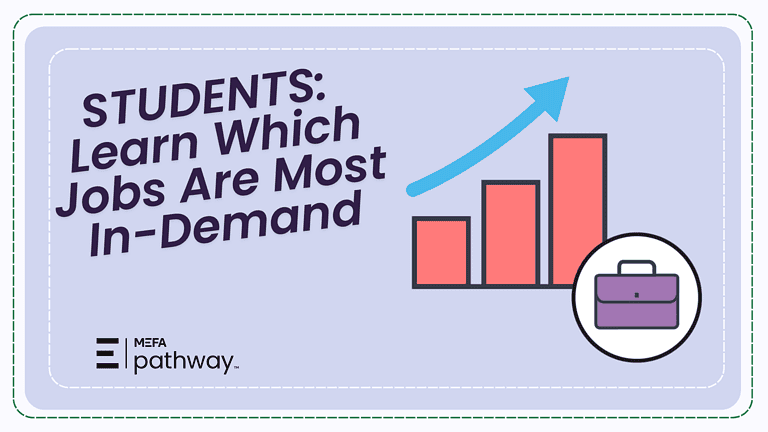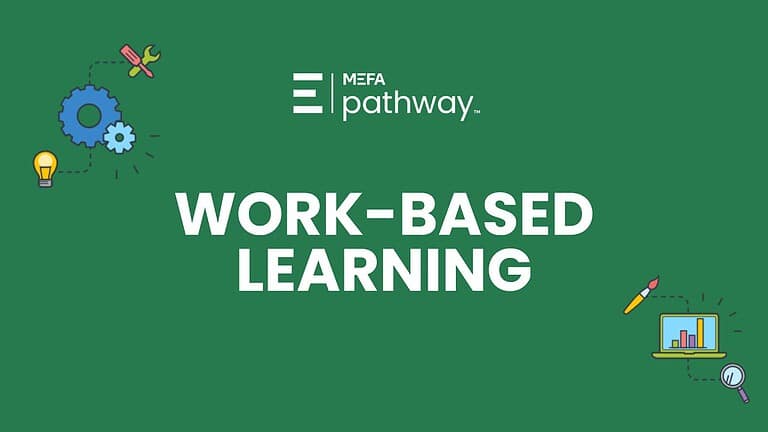Did you just graduate from high school and are wondering how to make a plan for your future? In this webinar, recorded in August 2023, we explain how to use MEFA Pathway, a free college and career planning website, to learn about colleges and careers and determine your next steps. MEFA Pathway is full of fun and interactive tools to help you discover what you enjoy, where you excel, and how these characteristics of YOU can be used to build your plan for the future.
Download the webinar slides to follow along.
Please note that this transcript was auto-generated. We apologize for any minor errors in spelling or grammar.
[00:00:00] Okay, let’s get started. Uh, welcome and thank you for joining today’s webinar, making a Plan for After High School as part of our summer series. The time is now.
My name is Jennifer Bento Pin. I’m here at MEFA on the college planning team as director of MEFA Pathway. And just a couple of logistics before we get started, um, on our presentation, uh, the audio settings, uh, allow you to control the volume. Of course, uh, you can. Um, we have disabled the chat, so if you have any questions as we go along, just pop those in the QA and we will address those at the end.
If you would, uh, [00:01:00] like to use the live transcript feature and like to see the, the closed captions you can do so, uh, and you can also select the link language of your choice. And then you’re always, um, welcome to leave. We hope you don’t, but, um, leave the webinar. We are recording this webinar. Uh, so you can always listen at a later date.
All right. A little bit about MEFA. Um, MEFA is a state authority created over 40 years ago to help uh, families in Massachusetts plan, save, and pay for college. So as an extension of all we do at MEFA MEFA Pathway is a college and career planning online platform. It’s available for students in Massachusetts and grades six through 12 and also recent graduates.
So today during our session here, we’ll be focusing on a few of the tools that are available, uh, in Mefa Pathway. Uh, but there is a lot to offer within the platform, so we always encourage you to come [00:02:00] back. Um. We’re going to go through that registration process, and so we always hope you’ll come back in and use the, use the platform further.
Okay, so let’s jump over to, I’m going to go to, um, the, the website, it’s MEFA pathway.org. We’re gonna go into the platform live here in just a couple of minutes. So, are you a recent graduate deciding on your plans for the future or possibly a student in high school developing a plan for after graduation?
I. So during this webinar, we’re going to learn about features within MEFA Pathway that can help guide you to determine next steps in building that solid career plan. So whether that’s attending a community college or a four year university, possibly getting into a trade program, going into the military, uh, so many options are available to you and it’s not too late to build a plan for the fall.
So again, this is MEFA pathway.org [00:03:00] and I’ll just point out before I go through the registration process at up on the right corner, uh, our site is translatable into the six languages. So you just click on which language you’d like to translate it to and it flips the whole, flips the whole website. So it’s pretty cool.
Alright, so mefa pathway.org. As a first time user, students will click, I am a student, and then they will go through the registration process. So very, very easy. First time user, click register here and the student will put in there and I’ll just put in some my. How it, how it works. So first name, last name, date of birth, city or town your school is in.
So. If you are currently attending school, you can select the town well either. Either way, if you’re attending, currently attending school or not, select the town that you live in. And then if you’re currently attending school, you’ll [00:04:00] see based on the city or town that you put in, there’s a list of schools within that district, or if you’re a recent graduate to select other.
Then submit. So the registration process will bring you through a second page here. So now some of the information is transferred from the first page. Your name and your date of birth. You can put in a, your, you wanna put in your address. So let’s just pop in my, my address here.
We’re gonna put the zip code in. Let’s see, 0 1, 8, 5, oh. You don’t have to add a mobile phone. So you see the city of talent comes over. I’m a recent grad, so I selected other, and then I say, I’m going to say I graduated. I graduated in 2023, and then you just click register. Then on the subsequent page you’ll create a username, you’ll create a password, and you will also input a working email address.
So [00:05:00] the email address, you wanna make sure that you have access to that email address so you can, um, if you forget your password, you can reset by that email address. You do create two security questions, so suggested that you. Uh, create questions that, uh, will not change. Like, uh, what is my brother’s name?
What is my sister’s name? Um, so two, two security questions. You can reset your password by that way as well. So either the email or the security questions if you forget. And then you just click the terms and conditions and your in. So let me go back to the log my login page here. ’cause I have credentials to my.
Account here. So after you create your credentials, when you log in, subsequently username, password, and then you log in. So pretty simple registration process. Pretty, pretty straightforward. So when you log into your account here, you will see, uh, your dashboard. So the [00:06:00] dashboard is a great spot. To view certain tasks and, and topics that are relevant, um, to future planning.
So some things to consider when you’re developing your plan. You wanna think about things that you’re excited about, what makes you tick, maybe some things that you might not be as excited about. You wanna think about skills that you have and how you can capitalize on those skills. You wanna think about your talents.
What are you passionate about? Do you wanna think about things that interest you? Uh, do you have an interest in, um, helping people? Do you have an interest with working with your hands? Uh, do you like working with numbers? So Mefa Pathway, um, can help determine some of these things in a, in a concrete way.
So I’m going to go over to, um, the Discover Careers tab up at the top here, and then from there I’m going to click on get to know myself. And on the Get to Know Yourself page, [00:07:00] there are three assessments that students have access to all which tie into the career search tool. So I’m going to show you how that works.
So just let’s look at the, what are your interests first? So click on get started, and the student students can come back and retake these. Assessment tests as many times as they like. It’s good to do so they can see, um, what’s trending with them, what may have changed. So in order to take this interest assessment students just click on, I’m just gonna click on start over.
Start over here. So there are 30 activities that the student rates from the very sad face to the very happy face. So install software across computers in a large network. Maybe that’s something that kind of, kind of intrigues me a little bit. Sell merchandise at a department store. Yeah, I don’t know if that really throws me too much.
So I’m not gonna go through these, all of these 30, but you get the idea. Uh, [00:08:00] students, you know, will go through the 30 and then once they do so they will be brought to a results page. So let me show you what that looks here, looks like. So once they get to the end, they’ve rated all of those 30 activities, they get to their results page.
And now they can see the rankings, uh, of the personality types based on their ratings to those questions. So you can see that based on my ratings I, my top is social second, investigative third enterprising. So you can get a little summary of each, what each of those means here. And then from here, students can click on, say they wanna see related careers to that social result.
I just click on that little, that little button, and it brings up a, a short list really, of maybe careers that they may want to explore further. So they would just click on a, click on a career and it would bring them, [00:09:00] I’ll show you to a, a nice, uh. Details page here. All the information on our careers comes from on net, so it’s updated on a regular basis.
So as you can see, I just selected that nurse practitioner, practitioner, and it brought me to a, a details page here. Projected growth, uh, required education level. Uh. A lot of information on this particular career. So if a student wants to save this career to their list, they can do so here. Just click save.
But let’s go back to the assessments just to show continue on with that. So that’s the interest assessment. We also have the work values assessment works in a similar manner. Students can, they can, if it’s been started, they can start over, but we. Encourage students that they complete the, the, the assessment.
So this one is just a drag and drop. So they read the value and they say how important that is to them from least to most. So they just click the [00:10:00] little plus sign and it, it, um, moves the, the value to that box. So once they complete that, and they can move these around too, if they like, oh, well I wanna move those around a little bit, they can do.
So once they complete that. This values assessment, they can then look at their results. So same sort of process here. And the page looks similarly as well. So top three results based on their ratings. And then again, they can click to see associated careers based on their, um, the selection. And then the final assessment that we have within the website here is what are my skills?
So this looks a little bit different. So students will rate their skills, uh, from, um, from high, average, low, and none. And these are, um, strengths based upon, uh, six categories. So [00:11:00] basic, complex problem solving, resource management, social, uh, systems and technical. So the student can, uh. That use logic and reasoning to identify the strengths and weaknesses.
Um, maybe they feel like they’re average in that capacity. So there are 32 skills that they rate, and then same process, they can see how those, um, like get to that results page. So, um, previous results here, I won’t bring you through the 32, but get, get the picture, how that works. Um, but then you can see, um, based off of the rating where the student rated themselves as, uh, most experienced, average little and no experience.
And then this pop-up allows the student to add their skills, their highest rated skills to their profile details. And that field feeds into a resume builder. Okay, so three assessments. What are my interests? What are my values? What are my [00:12:00] skills? So once students have gone through those assessments, then I’d like to show you how they can apply those results to a career search.
So we’re still under Discover careers. We’re going to click on career search. So this is where the student has the opportunity to apply their results. To a comprehensive career search. So let me just scroll down here. Let me just explain this page a little bit so the student can filter out, uh, a list of careers by education level, and I’ll show you how that works in just a moment.
If a student has a career category in mind that they would like to look at further, let me just give you an example. Say we have a student who may want to go into the health profession and they’re just starting out that journey of, of looking at careers that fit into that. So they just click on that Health and Human Services.
Maybe they’re thinking that they would like to go to school, uh, for vocational [00:13:00] training or a two year degree. They can click on. Click on the ed education level filter here. And as you can see, as I add filters, the number of careers goes down. So this is a, a filtered list based on, based on what I added, um, to my filters.
And then I, we have, um, students can click if there’s something on this list that they would like to explore further, can just click on the career and it will bring them to that career details page. So let’s clear out this ’cause I would like to show you how if a student has maybe a particular career in mind, they can app, they can add that to this page.
So I’m going to apply my values results, so I’m just going to click on use my Values. So. My top three values from that assessment is brought in as a filter to this page automatically. So you can see my top three values were achievement, [00:14:00] relationship, and work conditions. I can do the same with the top interests and I can also apply the skills so.
Obviously if you’re applying more filters, then the, the list narrows down further. So for just demonstration purposes, I’m going to sh apply my values results, and then say I’m a person that’s thinking that they may wanna go into some kind of fire science, you know, maybe becoming a, a, uh, maybe looking at, let’s see if I, did I search it there?
Um, I’m just gonna put in the search. Fire. And then I’m also going to apply the education level. So maybe I’m a student that would like to go to school for vocational training or a two year degree. So just based on that, I can see that we have two, two results here, and I’m gonna say forest fire inspector and prevention specialist.
It’s kind of interesting to me, so I’m going [00:15:00] to click on that. It brings up to this details page, which I showed you a few minutes ago with a different career. Um, so this is a force fire inspector prevention prevention specialist, and you can see. Summary at the top here. Projected growth, what career category.
This career falls into required education level. And then again, as we scroll down, you can see a lot of great details of, uh, daily tasks of this particular profession. Uh, work at what work activities may include. There’s a little, there’s a video here. Typically, those are about 90 seconds long. You can listen to somebody describe what they do in a day, what their job entails, more careers like this.
And then as we scroll down to the bottom here, you’ll see if the student has identified top skills high, that they’re high in, those will be applied here. And then also if they’ve taken that interest assessment work, values assessment, how this career [00:16:00] matches up to their results. So let me scroll back up here because I wanna take it one step further.
So we have within this box here. Programs of study. So these are programs of study that are related to this career that we, we have on, on the page here. So I would like to look at firefighting, fire science, and firefighting. I wanna be a firefighter, so I’m going to click on that program of study. And what this does is this brings.
Student to the college search page. So all of the co colleges within the United States that have this particular program of study are listed. Our database comes from, uh, Peterson’s. So that’s also updated on a regular basis. So within the United States, there are 324 undergrad schools and programs, um, that are found within these, these, these schools.
[00:17:00] So now what the student can do is maybe, you know, maybe they don’t wanna go outta Massachusetts, and that’s, that’s okay. Let’s, so let’s see what schools offer this program, this fire science program within Massachusetts. All I did was I. Went to the region and selected Massachusetts. So now we’re seeing that within Massachusetts we have seven schools that offer this fire science firefighting program.
So now from here, I would like to say I live in the Brockton area and I wanna be able to commute to school. So I’m gonna see what Massasoit has to offer. So you can see the location, what type of school that is, the tuition. Uh, deadlines for the application, as you can see. Uh, and then as we scroll down here, you can see those majors and degrees that are offered at that school.
So let’s expand this out and just to confirm that fire science is part of their curriculum. So [00:18:00] let’s see here. Yep, here it is under Homeland Security, law Enforcement, firefighting. So you can see that, um, that is offered at this particular institution. So then we can scroll down to the very bottom. Put that as less so we don’t, and then you can see contact information for that school, thus a direct link to the school’s website and to the admissions website.
All right, so we student can then, if they would like to save this college to their list. So potentially they’ve saved firefighter to their career list. They’ve saved, uh, mass soy at community college to their college list so they can go back to those lists to review. To really confirm a direction that they would like to go.
So here are all the colleges that the student has on their list, and you can see masses soya added here. So whether you are a current high school student or a recent graduate, we encourage you to create an account in me, a [00:19:00] pathway to help determine your next steps in building that career plan.
Additionally, let me jump over here. To the script, great website that we have. Um, this is, um, MEFA dapp.org/your future and this is a dedicated page, uh, to guide and assist students in making a plan for the future. So here we are. Um, lemme just scroll down and walk you through this a little bit. So again, the website is MEFA.org/your future.
And we have up at the top here, a direct link to Mefa Pathway, uh, the, the website I just walked you through a little bit of, uh, getting started. If you, uh, need help in getting started in using Mefa Pathway, you just click on this little button here and you can schedule a time to meet, uh, one-on-one with someone from our team to help you, uh, get you through that easy process.
But sometimes, [00:20:00] you know, or if you have questions, of course. Um, we have these upcoming webinars, uh, to help you plan, uh, for this fall, uh, in future paths. Uh, so we have, uh. As you can see, we have a handful here. Great. We have our FAFSA festival. So if you’re considering attending a community college in the fall and you need help filling out the fafsa, uh, join us on, we have two times that we’re offering here.
They’re drop-in times, uh, 10 to 12 and four to six. We’ll pair you with an expert, a one-on-one to help you, uh, complete your fafsa. And then we have, um, saving money on community college with mass mass transfer. So this is where you can learn about the cost saving benefits of starting college at a community college and transferring to a a public state university.
And that is highlighting a tool within nefa Pathway. And then we also have a, uh, a webinar. Um, featuring, uh, how you can learn more [00:21:00] about, um, trends, job growth potential, uh, in which careers are popular in different parts of the country to help you make a plan for the future. So and so, lots going on, lots of great stuff going on here.
And then if we scroll down the bottom, we have information on mass community colleges and then a link, uh, to some, uh, financial aid resources. Also helpful podcasts, of course, always fun to listen to and blog posts. So we have a lot of resources and, and a lot of, um, of guidance offered. Um, so let me go back here and just, let’s see.
Let’s get back to this slide here. Let’s see.
Oh, sorry about that.
Oh, there we go. [00:22:00] Okay, so, uh, lemme just go back one here. So, always posting on social media offering guidance and resource. So follow us on Facebook. Um, Instagram, I. Uh, LinkedIn, uh, always offering, again, great guidance and resources. And then of course, if you have questions, we’re always here to help. Uh, we have our college planning team, uh, that are answering calls Monday through Friday.
Uh. Not during the summer, nine to six. Uh, you can always shoot us an email or take advantage of those, uh, those one-on-one sessions that we offer. You can meet with someone from our team. Always happy to, to, to speak with people. Uh, so let’s open this up for questions. If anyone has any questions on anything that we covered during this webinar, uh, just pop that right.
Pop that right in the, um, in the qa.
I don’t [00:23:00] see any questions coming our way here. I’ll give another couple seconds here before we wrap it up. Alright. It doesn’t look like there are any questions. Thank you for joining today. And again, don’t hesitate to reach out to us. Take advantage of that, um, of that great webpage. Again, that’s MEFA.org/your future and create an account in MEFA Pathway.
Lots of, lots of, um, great tools and features in there that students can take advantage of. All right, have a great day. Thank you.













